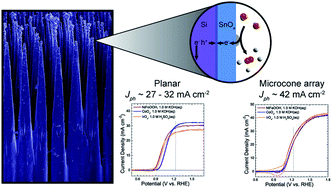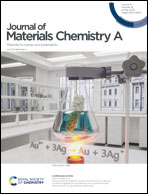Conformal SnOx heterojunction coatings for stabilized photoelectrochemical water oxidation using arrays of silicon microcones†
Abstract
The efficiency of photoelectrodes towards fuel-forming reactions is strongly affected by surface-based charge recombination, charge-transfer losses, and parasitic light absorption by electrocatalysts. We report a protective tin oxide (SnOx) layer formed by atomic-layer deposition that limits surface recombination at n-Si/SnOx heterojunctions and produces ∼620 mV of photovoltage on planar n-Si photoanodes. The SnOx layer can be deposited conformally on high aspect-ratio three-dimensional structures such as Si microcone arrays. Atomic-level control of the SnOx thickness enabled highly conductive contacts to electrolytes, allowing the direct electrodeposition of NiFeOOH, CoOx, and IrOx electrocatalysts for photoelectrochemical water oxidation with minimal parasitic absorption losses. SnOx-coated n-Si microcone arrays coupled to electrodeposited catalysts exhibited photocurrent densities of ∼42 mA cm−2 and a photovoltage of ∼490 mV under 100 mW cm−2 of simulated solar illumination. The SnOx layer can be integrated with amorphous TiO2 to form a protective SnOx/TiO2 bilayer that exhibits the beneficial properties of both materials. Photoanodes coated with SnOx/TiO2 exhibited a similar photovoltage to that of SnOx-coated photoanodes, and showed >480 h of stable photocurrent for planar photoelectrodes and >140 h of stable photocurrent for n-Si microcone arrays under continuous simulated solar illumination in alkaline electrolytes.



 Please wait while we load your content...
Please wait while we load your content...